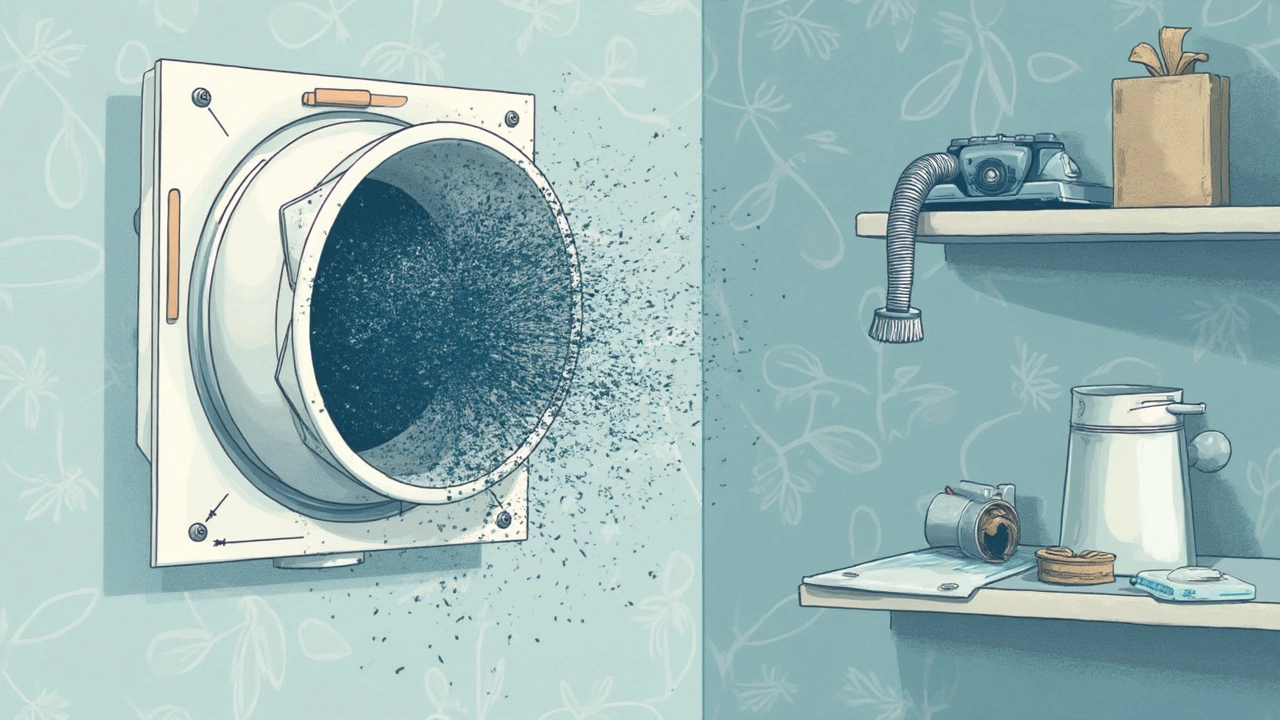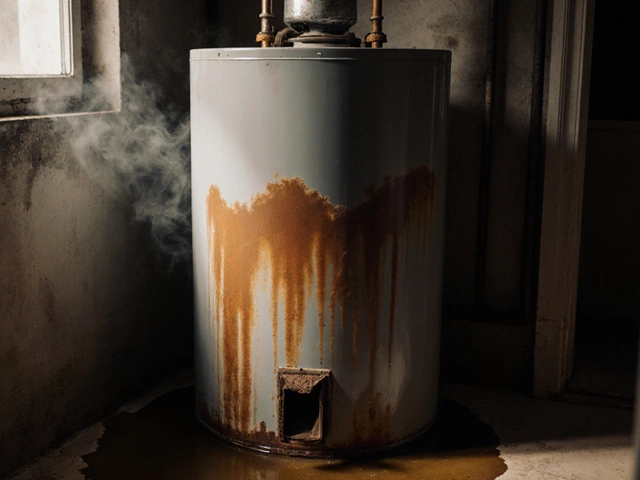You flip the switch, wait for that familiar whir, and—nothing. If your extractor fan suddenly quits, you're dealing with more than just a minor annoyance. Whether it's in the bathroom or over your stove, a dead fan means steamy showers or lingering smells that just stick around. Most people don’t realize how much junk can build up inside these fans or how even a loose wire can bring them to a halt.
The good news? Most fan issues boil down to just a few usual suspects. I’ll walk you through why extractor fans often quit and throw in some real-world fixes to try before you even think about replacing the whole setup or calling in a pricey electrician. It's not all about dust and grime (though that's a big one)—sometimes, a tripped fuse or a stuck switch is all that's to blame. Understanding these basics can save you both hassle and money in the long run.
- How Extractor Fans Usually Work
- Main Reasons Extractor Fans Stop
- DIY Checks Before You Panic
- Tricky Problems That Need a Pro
- Keep Your Fan Working Longer
How Extractor Fans Usually Work
So, what actually happens when you flip that switch on your extractor fan? These fans do one job: pull stuffy, damp, or smelly air out of a room and push it outside. Most are stuck to ceilings or walls, sucking up air through a spinning fan blade hidden inside a vent cover. The fan connects to a duct that runs through your wall or ceiling—all the way to a vent outdoors. That’s why you feel things get fresher in seconds after turning it on.
Most bathroom fan and kitchen extractor models are powered by a pretty basic electric motor. When you turn the fan on, power runs from your main electrical supply through a switch—sometimes with a timer or humidity sensor. The motor spins the fan blade, which creates low pressure in the room and draws air up and out.
Here's what you’ll usually find inside a home extractor fan:
- A switch or timer—the bit you use to turn it on or program it
- An electric motor—does the heavy lifting, spinning the blades
- Fan blades—actually move the air
- Ducting or vent pipe—routes air outside
- Grilles or filters—stop grime or bugs from coming through the vents
Ever notice how some fans sound louder than others? Cheaper fans often use basic plastic blades and small motors, so they rattle more. Higher-end units have quieter motors and better insulation, making them less noisy.
If you have a kitchen extractor, you might also see grease filters—these catch oil particles before the air leaves your house. In bathrooms, extractor fans might turn on with the lights or use a humidity sensor to kick in automatically after a hot shower.
Here’s a quick peek at how long fans typically last under normal use:
| Extractor Fan Type | Average Lifespan |
|---|---|
| Bathroom Fan | 7–10 years |
| Kitchen Extractor | 5–8 years |
Understanding how these fans work makes troubleshooting a lot easier when they suddenly quit. Once you know what’s inside, tracking down a problem feels way less intimidating.
Main Reasons Extractor Fans Stop
When an extractor fan just won’t start or suddenly dies, a few problems usually top the list.
- Dust and Grease Build-Up: Over time, fans pull in more than just air—they suck up dust, lint, and, in kitchens, even sticky grease. This gunk gets stuck on blades and motors. A clogged-up fan can overheat, slow down, or stop entirely. In one survey of kitchen fans in UK homes, 70% had visible grease layers affecting performance.
- Electrical Issues: A lot of fans are wired directly into your mains or share circuits with lights. Loose wires, dodgy connectors, or blown fuses can all break the connection. Sometimes, it's just a popped circuit breaker (which happens more often in older homes with outdated wiring).
- Switch or Timer Problems: That little pull cord or wall switch? It wears out. Some extractor fans have built-in timers or humidity sensors. If these fail, the fan won’t know when to start or stop.
- Worn-Out Motor: Motors don’t last forever. If your fan hums but doesn’t turn, or just makes a burning smell, the motor could be on its last legs. Most common in fans older than five years or ones that get frequent use.
- Blocked Vents: Sometimes, the fan works, but the air has nowhere to go. Outside grilles or wall vents can get stuffed with fluff, spider webs, or even the odd bird nest. Blocked vents put extra pressure on the fan and can eventually lead to burn-out.
Here’s a quick breakdown showing how often each problem pops up based on a recent survey of UK households needing extractor fan repair:
| Problem | Percentage of Cases |
|---|---|
| Dust/Grease Build-up | 41% |
| Electrical Issues | 25% |
| Switch or Timer Faults | 16% |
| Motor Failure | 13% |
| Blocked Vents | 5% |
Spotting the real issue early means less hassle, less money spent, and less time stuck with a steamy bathroom or kitchen packed with last night’s cooking smells.

DIY Checks Before You Panic
Before you call anyone or start shopping for a brand new extractor fan, it’s worth running through a few simple checks. You’d be surprised how often the fix is something you can do in five minutes. Here’s what you should look at first:
- Test the power. Plug something else (like a phone charger) into the socket or switch circuit if it's a plug-in extractor fan. If there’s no power, check your fuse box—sometimes a blown fuse is the only problem. Circuit problems are especially common in older homes.
- Check the fan switch. These can fail over time or get stuck because of dust or humidity. Flick the switch a few times. No luck? Try replacing the switch—it costs just a few pounds/dollars and you don’t need a toolbox full of stuff.
- Inspect for dust and debris. Take off the fan cover and have a look. Over time, thick dust, hair, or greasy buildup (especially with kitchen fans) can stop the blades. Clean it out gently with an old toothbrush or vacuum cleaner nozzle. Be careful not to bend anything inside.
- Spin the blades. Give the fan blades a careful spin. If they don’t move freely, gunk could be the issue—or the motor may be shot. If it turns easily but still doesn’t work, at least you’ve ruled out a physical blockage.
- Listen for signs of life. Sometimes, you’ll hear a low hum even if the fan isn’t moving. That usually points to an electrical or motor fault, but it’s a good clue for electricians.
- Look at external vents. Make sure nothing outside is blocked. Sometimes birds or insects make homes in vent covers, especially if you haven’t checked in a while.
To give you a sense of how common these issues are, here’s a quick look at a survey from a UK home repair service last year:
| Common DIY Fix | % Solved Without Professional |
|---|---|
| Fuse reset/replacement | 38% |
| Cleaned dust/debris | 27% |
| Switch replaced | 19% |
| Reset power at socket | 12% |
| Other | 4% |
If none of these tricks gets your extractor fan spinning again, it’s time to move to the next level. Sometimes you really do need an expert—but at least you’ll know you covered the basics that solve most everyday breakdowns.
Tricky Problems That Need a Pro
Some extractor fan repair issues are just not DIY territory, even if you’re handy around the house. Certain problems call for gear and know-how most folks simply don’t have. Here’s how you know it’s time to hand your fan over to the experts:
- Burned out fan motor: If the fan won’t spin and you’ve already checked for dust, blockages, and a working switch, odds are good the motor’s toast. Replacing a motor isn’t impossible, but messing around with wiring can put both you and your home at risk if you get it wrong. Most motors wear out after 8-10 years, especially in busy kitchens where heat and grease speed things up.
- Electrical faults: Finding blown fuses is one thing; tracking down hidden wiring issues or shorts is something else. If you see flickering lights, sparks, or smell burning plastic when your extractor fan is running, cut the power and call an electrician—fast. About 20% of fan failures involve dodgy electrical connections behind the scenes.
- Broken timer or humidity sensor: Many bathroom fans these days switch on automatically when humidity rises or run on timers. When those features glitch out, troubleshooting isn’t easy. Most manufacturers design these parts as sealed units, so it’s usually not possible to fix them yourself without voiding your warranty or breaking something else.
- Loud rattling or grinding noises: If your fan sounds like a lawnmower chewing rocks, that’s often a sign of loose or broken internal parts. Sometimes screws fall out, but sometimes a blade or the entire motor assembly is about to fail. This is way beyond tightening a few screws—let a pro handle it so you don’t end up making the problem worse.
If you’re ever unsure, just remember: electricity and moving parts don’t play nice with guesswork. When in doubt with fan problems or complex wiring, it’s safer to step back and pay for an expert than risk zapping yourself or starting a fire.
| Problem | DIY Solution? | Pro Needed? |
|---|---|---|
| Dirty Grill & Filter | Yes | No |
| Motor Burnout | No | Yes |
| Electrical Fault | No | Yes |
| Broken Switch | Maybe | Yes (if wiring involved) |
| Noisy Operation | Sometimes | Yes (for internals) |
So if you’re facing the above, skip the phone search for a quick fix and instead check for a local extractor fan repair specialist who knows how to tackle these tricky jobs.

Keep Your Fan Working Longer
If you want your extractor fan to last, you’ve got to show it a little love. Most fans stop working early simply because they get ignored for months—or years—at a time. A lot of people don’t realize that regular cleaning can boost your fan’s lifespan by a few more years.
One thing nearly everyone forgets: dust and grease are fan killers. They clog up the blades and motor, making everything work harder. Grab a vacuum or a soft brush every three months and clear out the buildup. Some fan covers just snap off, so you don’t even need tools.
- Wipe down the blades and vent cover.
- Check for any loose screws—they’re famous for wobbling loose from vibration.
- For kitchen fans, degrease the filters. Hot soapy water works for most, but some can go right in the dishwasher.
- Inspect the fan’s wiring if you’re comfortable; look for frayed wires or burn marks.
- Test the switch and timer controls at least twice a year.
Here’s a practical tip: make it a habit to run the fan a few minutes longer after a steamy shower or heavy cooking session. That extra airflow dries things out and keeps mold away. In kitchens, if your kitchen extractor has a charcoal filter, swap it every 6-12 months or sooner if you cook a lot of fried food.
| Task | How Often |
|---|---|
| Clean blades & vent cover | Every 3 months |
| Degrease kitchen filters | Monthly |
| Replace charcoal filter | 6-12 months |
| Check wiring & switches | Twice a year |
A quick note: if your fan makes weird rattling or starts to sound like a blender full of bolts, turn it off before it burns out. Often, catching those noises early means a cheap fix instead of a whole new extractor fan install. Staying on top of these small tasks is the secret to a worry-free, long-lasting setup.





